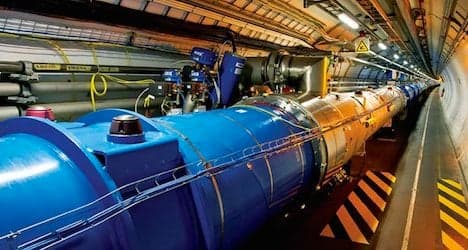CERN fires up particle smasher after upgrade

The world's largest particle smasher resumed colliding protons Tuesday as it gradually reboots following a two-year upgrade, the Geneva-based European Organization for Nuclear Research (CERN) said.
The low-energy collisions took place in the Large Hadron Collider (LHC) Tuesday morning, CERN said in a statement.
The protons collided at an energy of 450 gigaelectronvolts (GeV), allowing the scientists to fine tune LHC's detectors as they prepare to crank the power up to allow collisions at an unprecedented 13 teraelectronvolts (TeV), it said.
Experiments at the collider are aimed at unlocking clues as to how the universe came into existence by studying fundamental particles, the building blocks of all matter, and the forces that control them.
In 2012, the LHC was used to prove the existence of Higgs Boson, the particle that confers mass, earning the 2013 Nobel physics prize for two of the scientists who, back in 1964, had theorized the existence of the so-called
"God particle".
Tuesday's collisions at the giant lab, housed in a 27-kilometre (17-mile) tunnel straddling the French-Swiss border, are part of preparations for the next experiments to delve into the mysteries of the universe.
LHC's previous highest power was eight TeV reached in 2012, but after the two-year overhaul, it will first reach 13 TeV and can potentially be cranked up to a maximum 14 TeV.
CERN said earlier that if all went well, collisions "at an energy of 13 TeV" could start as early as June.
During the next phase of the LHC programme, researchers will probe a conceptual frontier called new physics, including antimatter and dark matter.
The latter is a theoretical type of matter that we cannot see but that is thought to make up most of the universe. It has only been detected by its gravitational effects
Ordinary, visible matter comprises only about four percent of the known universe.
The LHC allows beams containing billions of protons travelling at 99.9 percent the speed of light to shoot through the massive collider in opposite directions.
Powerful magnets bend the beams so that they collide at points around the track where four laboratories have batteries of sensors to monitor the smashups.
The sub-atomic rubble is then scrutinized for novel particles and the forces that hold them together.
Comments
See Also
The low-energy collisions took place in the Large Hadron Collider (LHC) Tuesday morning, CERN said in a statement.
The protons collided at an energy of 450 gigaelectronvolts (GeV), allowing the scientists to fine tune LHC's detectors as they prepare to crank the power up to allow collisions at an unprecedented 13 teraelectronvolts (TeV), it said.
Experiments at the collider are aimed at unlocking clues as to how the universe came into existence by studying fundamental particles, the building blocks of all matter, and the forces that control them.
In 2012, the LHC was used to prove the existence of Higgs Boson, the particle that confers mass, earning the 2013 Nobel physics prize for two of the scientists who, back in 1964, had theorized the existence of the so-called
"God particle".
Tuesday's collisions at the giant lab, housed in a 27-kilometre (17-mile) tunnel straddling the French-Swiss border, are part of preparations for the next experiments to delve into the mysteries of the universe.
LHC's previous highest power was eight TeV reached in 2012, but after the two-year overhaul, it will first reach 13 TeV and can potentially be cranked up to a maximum 14 TeV.
CERN said earlier that if all went well, collisions "at an energy of 13 TeV" could start as early as June.
During the next phase of the LHC programme, researchers will probe a conceptual frontier called new physics, including antimatter and dark matter.
The latter is a theoretical type of matter that we cannot see but that is thought to make up most of the universe. It has only been detected by its gravitational effects
Ordinary, visible matter comprises only about four percent of the known universe.
The LHC allows beams containing billions of protons travelling at 99.9 percent the speed of light to shoot through the massive collider in opposite directions.
Powerful magnets bend the beams so that they collide at points around the track where four laboratories have batteries of sensors to monitor the smashups.
The sub-atomic rubble is then scrutinized for novel particles and the forces that hold them together.
Join the conversation in our comments section below. Share your own views and experience and if you have a question or suggestion for our journalists then email us at [email protected].
Please keep comments civil, constructive and on topic – and make sure to read our terms of use before getting involved.
Please log in here to leave a comment.